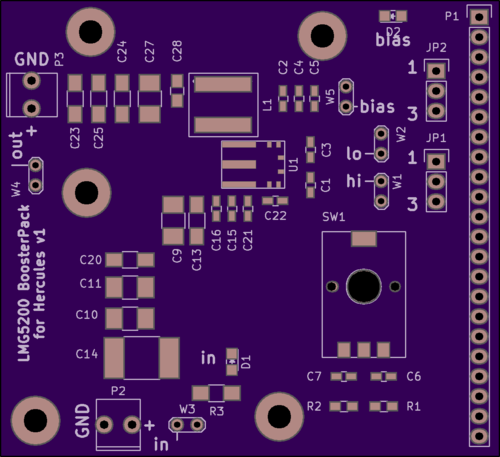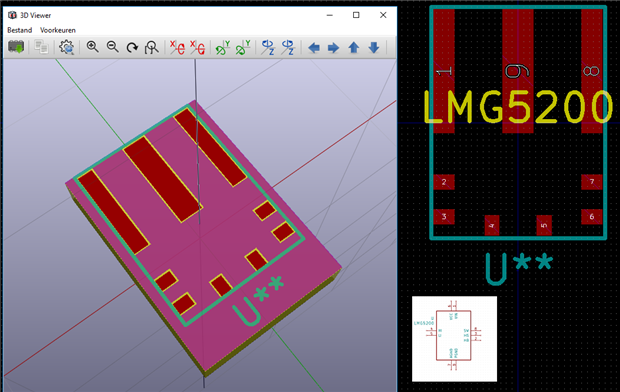I'm designing a BoosterPack to evaluate GaN devices with the help of a microcontroller.
The kit will have a GaN half-bridge that can control an output of 20V and 10A. Currently the prototype can control switching frequency and duty cycle. I'm also planning a stretch goal to integrate the design with LabView. You can then use this as a part of a test setup. |
The Design Exists
I have a working prototype. I modded an existing LMG5200 evaluation kit a while ago.
I removed the discrete PWM generator and replaced it with microcontroller managed signals.
This proof of concept works, both electronics and firmware. I can make a more sturdy version now.
The switching layout is fully based on the design guidelines and the evaluation kit's PCB.
Because of the high switching frequencies and high currents, that part of the design is critical.
I'm trying to place all components similar to the application notes. This will be my first 4-layer PCB design.
Status
I have the schematic ready.
I had to create a few components and footprints (both for LMG5200 and rotary encoder, footprint only for the inductor).
For the PCB, I have a provisional layout. I haven't routed a single trace yet.
But I have uploaded that intermediate status to OSHPark to get an idea of how this device will look like.
Before doing that routing, I first have to verify if I can source all the components that I'm planning to use.
In particular the SMD 360° rotary encoder may be a tricky purchase.
To be continued...






Top Comments
-

jc2048
-
Cancel
-
Vote Up
+1
Vote Down
-
-
Sign in to reply
-
More
-
Cancel
-

Jan Cumps
in reply to jc2048
-
Cancel
-
Vote Up
+1
Vote Down
-
-
Sign in to reply
-
More
-
Cancel
-

jc2048
in reply to Jan Cumps
-
Cancel
-
Vote Up
+1
Vote Down
-
-
Sign in to reply
-
More
-
Cancel
-

Jan Cumps
in reply to jc2048
-
Cancel
-
Vote Up
0
Vote Down
-
-
Sign in to reply
-
More
-
Cancel
-

Jan Cumps
in reply to jc2048
-
Cancel
-
Vote Up
0
Vote Down
-
-
Sign in to reply
-
More
-
Cancel
-

Jan Cumps
in reply to jc2048
-
Cancel
-
Vote Up
0
Vote Down
-
-
Sign in to reply
-
More
-
Cancel
-

Jan Cumps
in reply to jc2048
-
Cancel
-
Vote Up
0
Vote Down
-
-
Sign in to reply
-
More
-
Cancel
Comment-

Jan Cumps
in reply to jc2048
-
Cancel
-
Vote Up
0
Vote Down
-
-
Sign in to reply
-
More
-
Cancel
Children